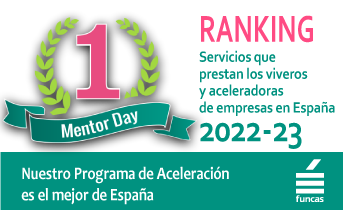HOW IS A SOCIAL ENTERPRISE FINANCED?
Accelerate your business with these expert tips on "How to finance a social enterprise" - take a look and discover this TIP!
Financing a social enterprise can be a unique challenge due to the dual mission of generating income and creating social impact. Social enterprise requires a certain amount of capital to open, grow or maintain.
Where do companies whose primary objective is not financial profit but prioritise social impact get their money from?
The reality is that they are financed in much the same way as any other business.
Founders' own funds
- The founding partners are usually the first to put up capital and their own time to start up the company.
This type of entrepreneurship is very vocational and tends to be related to some personal situation in the partners' past, so it is normal to involve family members in the financing of the project, especially at the beginning.
Friends, family and fools (+), a call to nearby contacts
Often, enterprises tend to be financed by loans or donations from close relatives, such as parents and other family members, close friends and even somewhat more peripheral people who have confidence in the original idea, such as acquaintances or friends of friends who have heard about the project.
Grants and Donations (+)
- Government subsidies: Some governments offer specific subsidies for social enterprises.
- Private donations: individuals or organisations can donate money to fund specific projects or for general operating expenses.
Impact Investment Angel Investment (+)
SOME INVESTORS ARE INTERESTED IN SOCIAL IMPACT IN ADDITION TO FINANCIAL RETURN, AND MAY BE WILLING TO INVEST AT EARLY STAGES:
- Impact inverters: these investors are looking for both a financial return and a social or environmental impact.
- Social investment funds: Some funds specialise in social enterprises and seek both financial and social returns.
Business angels - 63 % are still male, although the trend could change - are an important supporter of any company seeking capital, and not all are looking for an investment with high returns on capital or any return at all.
Philanthropy has multiple aspects and profiles, according to the CaixaBank and IE University report on the profile of Spanish philanthropists. But whatever the why, what or how of the philanthropist, financing social enterprises falls within their scope of action.
Sales and Operating Income
If the social enterprise has a saleable product or service, the income generated can be reinvested in the enterprise.
Strategic Alliances
Collaborating with larger companies can provide funding and resources. In return, the larger company can improve its corporate social responsibility.
Competitions and Prizes
Participating in social entrepreneurship competitions can offer both funding and visibility.
Crowdfunding or participatory financing (+)
Platforms such as Kickstarter or Indiegogo can be useful for raising small amounts of money for a specific project.
The crowdfunding or micro-patronage mechanism is a This is highly advisable for social enterprises, precisely because of their support for the society that forms the "crowd". Crowdfunding is perfectly suited to this type of business, which is looking for more than just money.
THERE ARE AN INCREASING NUMBER OF CROWDFUNDING MODELS, ALTHOUGH DONATION, REWARD AND INVESTMENT ARE THE MOST COMMON:
- DONATION. The money transfers are made without remuneration, without expecting anything in return and in solidarity and altruism.
- REWARD (+). Sending money in exchange for some kind of object or service, such as a book or a mug.
- INVERSION is more classical (+). The investor seeks to recover capital, often with interest.
Participatory social finance can use any of the three, or even a combination of them along with other avenues.
Leasing (+), factoring (+) y confirming (+)
According to Cesgar's report The financing of SMEs in Spain, financial instruments such as leasing (hire-purchase contracts), confirming (deferring payment of invoices because they are backed by a financial institution) and factoring (advance payment by customers) help many SMEs to finance themselves, although they are not widely accepted forms of financing.
SLIGHTLY MORE THAN 12% OF COMPANIES MAKE USE OF THE:
- Leasing (+).
- Only one 2.8 % uses the confirming (+).
- The factoring (+) is used by the 1,7 %.
Bank credit. Loans
- Low-interest loans: some organisations offer low-interest loans for social enterprises.
- Microcredits: these are small loans that can be especially useful for early stage social enterprises.
Bank loans are the main source of financing for SMEs. 27 % of the liquidity needs were met by bank loans (+).
Social loans: financing with social impact
There are also social enterprise financing instruments tailored to the needs of these businesses. Social loans, such as MicroBank's Social Enterprise Loan, are an example aimed at projects that pursue goals that are broader than economic profit, environmentally friendly, responsible and sustainable. This loan is viable thanks to the European Investment Fund (EIF) and InvestEU.
Why does a social enterprise need capital?
By not pursuing economic profit as the ultimate goal, social enterprises can have a The challenge of capitalising their work with own funds, especially in the early stages, is greater. This is because monetisation options are often much more limited than in the sale of conventional products or services.
They may also be more constrained in traditional financing channels, where they often the social impact is not valued as a benefit of the project, as some recent reports recall. However, cThey have a number of financing instruments that will enable them to obtain the funds they need, some of them even tailor-made for them.
A social enterprise, like any other type of enterprise, needs capital for a variety of reasons that go beyond mere survival.
SOME OF THE KEY REASONS ARE DESCRIBED BELOW:
Start-up and Initial Operations
- Product/Service Development: prototyping, testing and improvement requires investment.
- Infrastructure: buying or renting space, technology, equipment, etc.
- Operating Expenses: costs such as wages, utilities, and raw materials need to be covered.
Scalability
- Geographical Expansion: opening new locations or entering new markets requires capital.
- Development of New Products or Services: expand the range of offerings to better serve the community or to diversify revenues.
Sustainability and Growth
- Cash Flow: maintain a healthy cash flow for day-to-day operations.
- Long-term investments: Whether in technology, employee training or R&D, long-term investments are crucial for sustainability.
Marketing and Visibility
- Advertising and Marketing: to raise awareness of the social cause and attract more customers or beneficiaries.
- Public Relations: Building a brand and gaining credibility also requires investment.
Measuring Impact
- Monitoring and Evaluation: To demonstrate social impact, social enterprises need robust monitoring and evaluation systems, which also require resources.
Resilience
- Reserve Fund: have a financial cushion for difficult times or to take advantage of new opportunities.
Compliance and Regulation
- Certifications and Licences: obtaining the necessary certifications and complying with regulations can be costly but necessary.
In a nutshell, capital is essential for a social enterprise to achieve its twin goals of social impact and financial sustainability.
APPLY THIS TIP TO YOUR PROJECT
- 💻 PRACTICE with an expert in the next practical webinar.
- 🔎 CONSULT more related TIPs with this same theme.
- 📖 AMPLIA your knowledge by downloading this EBOOK.
THINK ABOUT YOU
- 🚀 IMPULSA your company in the next acceleration programme, ¡book your place now!
- 🥁 PRACTICE with your project in this practical webinar, ¡apply for your place!
- 🌐 CONTACT with other entrepreneurs and companies, ¡register and take part in the next Networking!
THINK ABOUT HELPING OTHERS
- 🤝COLLABORATE as a volunteer: expert, mentor, inverter, awarding, Spreading the word, challenging, innovating, creating a TIP...
- 💬 RECOMMENDS this programme to reach out to more entrepreneurs by Google.
- 👉 SHARE your learning!
- 📲 SEND this TIP 👇









